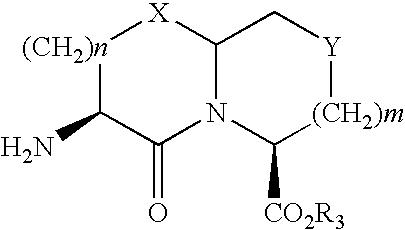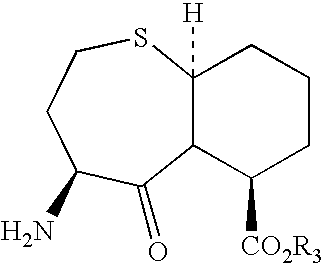N-carbobenzyloxy (n-cbz)-deprotecting enzyme and uses therefor
- Summary
- Abstract
- Description
- Claims
- Application Information
AI Technical Summary
Benefits of technology
Problems solved by technology
Method used
Image
Examples
example 1
Selective Techniques for Isolation of Microrganisms
[0143] A selective culture technique was used to isolate microorganisms that able to utilize N-α-CBZ-L-lysine as a sole source of nitrogen. Soil samples were collected from various sites in New Jersey. About a gram of soil samples suspended in 5 mL of water, mixed thoroughly and samples were allowed to settle. The supernatant solutions from various samples were inoculated in a medium A (2% glucose, 0.2% KH2PO4, 0.2% K2HPO4, 0.01% MgSO4, 0.001% FeSO4, 0.001% ZnSO4, pH 7.0) containing 1% N-α-CBZ-L-lysine. After 4 days of growth when medium became turbid, cultures were transferred to the above medium containing 1.5% agar contained in petri plates. From this enrichment culture techniques eight different types of colonies were isolated. One culture (Z-2) was further identified as Sphingomonas paucimobilis strain and was deposited in American Type Culture Collection, Rockville, Md. as Sphingomonas paucimobilis strain ATCC 202027. This cu...
example 2
Growth of Sphingomonas paucimobilis
[0144]Sphingomonas paucimobilis was grown on N-α-CBZ-L-phenylalanine or [4S-(4α,7α, 10αβ)]-Octahydro-5-oxo-4-[[(phenylmethoxy)carbonyl]amino]-7H-pyrido-[2,1-b] [1,3]thiazepine-7-carboxylic acid, methyl ester (Compound A) as sole source of nitrogen. The Sphingomonas paucimobilis culture was inoculated in a medium A containing 1% N-α-CBZ-L-phenylalanine or 1% Compound A. After 2 days of growth, cultures were transferred to the medium A containing 1% N-α-CBZ-L-phenylalanine or 1% BMS199541, and 1.5% agar contained in petri plates. The colonies were isolated from the petri plates were grown in 100 mL of medium B (0.015% yeast extract, 2% glucose, 0.2% KH2PO4, 0.2% K2HPO4, 0.01% MgSO4 and 0.2% NaCl, pH 7) containing 1% N-α-CBZ-L-phenylalanine and or 1% Compound A. Culture was grown at 28° C. and 280 RPM for 24 hours on a rotary shaker. Vials were prepared (1 mL culture in a 2 mL vial) from this culture and were stored at −70° C. for future use.
[0145] ...
example 3
Biotransformation Using Whole Cells
[0146] In this process, the Sphingomonas paucimobilis was grown in 25 mL of medium B containing 25 mg of substrate (Compound A or CBZ-L-Phenylalanine) in a 250-mL flask. The flask was incubated at 28° C. and 250 rpm on a shaker. After 48 hours of biotransformation, the cells were removed by centrifugation. The supernatant containing the product [4S-(4α,7α,10αβ)]-Octahydro-5-oxo-4-amino-7H-pyrido-[2,1-b] [1,3]thiazepine-7-carboxylic acid, methyl ester (Compound B) or L-Phenylalanine was analyzed by HPLC. The results are shown in the table 1.
TABLE 1SubstrateProduct% ConversionCompound ACompound B100CBZ-L-PhenylalanineL-phenylaline100
[0147] HPLC analysis was performed using a Hewlett-Packard (HP) 1090 instrument with a Vydac C-18 reverse phase column. The mobile phase solvent A containing 0.1% trifluoroacetic acid (TFA) in water and solvent B containing 0.1% TFA in 70% acetonitrile: 30% water. The following gradient of solvent A and ...
PUM
| Property | Measurement | Unit |
|---|---|---|
| temperatures | aaaaa | aaaaa |
| temperatures | aaaaa | aaaaa |
| temperature | aaaaa | aaaaa |
Abstract
Description
Claims
Application Information
 Login to View More
Login to View More - R&D
- Intellectual Property
- Life Sciences
- Materials
- Tech Scout
- Unparalleled Data Quality
- Higher Quality Content
- 60% Fewer Hallucinations
Browse by: Latest US Patents, China's latest patents, Technical Efficacy Thesaurus, Application Domain, Technology Topic, Popular Technical Reports.
© 2025 PatSnap. All rights reserved.Legal|Privacy policy|Modern Slavery Act Transparency Statement|Sitemap|About US| Contact US: help@patsnap.com



